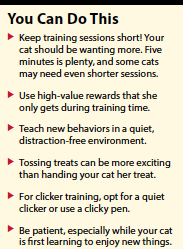Cats are smart, and extremely good at training us. But cats can also be the trainee and can learn pretty much any skill that a dog can learn.
Mary Cope, PhD, has taught her cat a host of tricks. “I taught her through luring and positive reward with treats. She knows sit, beg, high-five, lie down, spin, and she will jump over my arm or an agility jump,” says Dr. Cope. Your cat can learn these skills and others, too.
Motivation is the key. “I think a huge component is having high value rewards,” says Dr. Cope. For her cat, crunchy treats are a special reward that she loves and only gets during training sessions. Other cats may prefer tiny bits of cooked chicken (hold the seasoning) or a dab of a “lickable” soft treat for cats.
 The Right Reward
The Right Reward
Feeding your cat measured meals will help with food motivation, and allow you to track her calories and be sure that she isn’t eating too much between her meals and training treats.
Toys can be a great reward too! Whether your cat loves jingly balls, feathered wands, or soft mouse-shaped plushies, you can use play as a reward when training.
Some cats may even find petting or praise to be the best reward of all.
Once you have found the reward your cat likes best, you are ready to start training.
Come
Teaching your cat to come when called can be one of the easiest behaviors to train. It is also very useful when you need to locate your cat quickly.
Decide how you want to call your cat, whether you just want to use her name or want her to learn the word “come.” Once you have decided on a verbal cue, you’re ready to begin.
Start in an empty room with few distractions, with your cat close by. Call your cat, and immediately present her with the treat or toy. She should come running for her reward. Repeat several times until she is responding to your verbal cue.
Move a few feet away from your cat and call. Reward as she responds and comes to you. Repeat several times.
Gradually increase the distance, including going into other rooms so your cat can’t see you when you call.
For food-crazy cats, mealtimes are an excellent opportunity to practice coming when called. Call your cat before you open her food, whether that be cracking a can or unrolling the top of a bag. After a few meals, she will quickly learn that your verbal cue is the first signal that food is coming and will respond to your call before she hears the usual meal-prep sounds. From here you can practice coming when called at other times of day, always rewarding her with a tasty treat.
Sit
Sit is easiest to train by luring.
Get your cat’s attention with her favorite treat or toy and hold it in front of her nose. Move the reward so that your cat tips her head back and then folds her back legs into a sit position. Praise and give her the reward once she sits.
Repeat several times until she starts to anticipate and sit with less help from you. The action of luring her nose into position becomes a hand signal.
Now you can add in your verbal cue. Say, “Sit,” before you present the lure. Repeat until she starts to react to the verbal cue, before you give your signal.
Stay
Teaching stay is easiest if your cat either has a favorite place to rest or already knows sit.
Start by getting your cat in position—either on her bed or sitting. Say, “Stay,” wait one second, and then reward. Repeat several times.
Next, wait two seconds before praising and rewarding. These tiny increments are critical so that your cat can be successful as she figures out what you want. Gradually increase the time between asking your cat to stay and rewarding her.
If your cat gets up too early, just calmly put her back in position and try again with a shorter stay.
Once your cat will stay for some duration, try adding distance. Tell your cat to stay, take one step away, then immediately return to her and reward. Gradually increase how far away you go.




